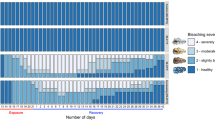Abstract
The growth and photosynthetic responses ofPterocladiella capillaceato NH4, PO4, CO2-enrichment, pH, irradiance and temperature were evaluated for winter or summer plants cultivated under laboratory and outdoor settings. In the laboratory, using a gradient table, optimal growth temperature and irradiance for winter plants occurred at 10–20 °C and 100 μmol photon m−2s−1, averaging 24.3% per week. The optimal growth conditions found for summer plants were 10–20 °C and 20 μmol photon m−2s−1, averaging 29.0% per week. In a pH-stat cultivation system photosynthetic rates and growth rates were largely unaffected by pH in the range 6.5–8.5, however, they both decreased significantly above 8.5. In outdoor settings, using 40 L tanks,P. capillaceawas more responsive to the frequency the algae were fed with NH4and PO4rather than the relative concentrations of these nutrients. The average growth rates during winter were 28.3% and 12.5% per week when NH4and PO4were included once and twice a week for 24-h periods, respectively, while summer plants grew 15.0% and 25.3% per week at these nutrient regimes. Algae grown in seawater (containing 13.8 ± 1.8 μM CO2) or CO2-enriched seawater (averaging 33.7 ± 13.2 μM CO2) had similar growth rates or even reduced productivity under CO2-enrichment during winter. Concentrations of chlorophyllawere in average significantly higher in winter as compared to summer especially when nutrients were included twice a week. Phycoerythrin levels were also higher for plants fed with nutrients twice a week particularly during summer time. Although agar yields were limited and not seasonally dependent, this study shows high growth capacity forP. capillaceaas compared to previous investigations. Future mariculture prospective using current tank cultivation techniques for this species will likely depend on market demands for high quality agar.
Similar content being viewed by others
References
Beer S (1994) Mechanisms of inorganic carbon acquisition in the macroalgae. In Round FE, Chapman DJ (eds), Progress in Phycological Research. Vol 10, Biopress Bristol, England, pp. 179–207.
Beer S, Eshel A (1985) Determining phycoerythrin and phycocyanin concentrations in aqueous crude extracts of red algae. Aust. J. mar. Freshwater Res. 36: 785–792.
Craigie JS, Leigh C (1978) Carrageenans and agars. In Craigie JS, Hellebust JA (eds), Handbook of Phycological Methods, Cambridge University Press, Cambridge, pp.109–132.
Cuotinho R, Yoneshigue Y (1988) Diurnal variation in photosynthesis vs. irradiance curves from “sun” and “shade” plants ofPterocladia capillaceafrom Cabo Frio, Rio de Janeiro. Brazil J. Exp. Mar. Biol. Ecol. 118: 217–228.
Dawes C (1998) Marine Botany. John Wiley & Sons, Inc., 496 pp.
Fredriksen S, Rueness J (1989) Culture studies ofGelidium latifolium(Grev.) Born et Thur. (Rhodophyta) from Norway. Growth and nitrogen storage in response to varying photon flux density, temperature and nitrogen availability. Bot. Mar. 32: 539–546.
Friedlander M (1992)Gracilaria confertaand its epiphytes. The effect of culture conditions on growth. Bot. Mar. 35: 423–428.
Friedlander M, Levy I (1995) Cultivation ofGracilariain outdoors tanks and ponds. J. appl. Phycol. 7: 315–324.
Friedlander M, Lipkin Y (1982) Rearing of agarophytes and carrageenophytes under field conditions in the eastern Mediterranean. Bot. Mar. 25: 101–105.
Friedlander M, Zelikovitch N (1984) Growth rates, phycocoloid yield and quality of the red seaweeds,Gracilariasp.,Pterocladia capillacea, Hypnea musciformis, andHypnea cornuta,in field studies in Israel. Aquaculture 40: 57–66.
Holbrook GP, Beer S, Spencer WE, Reiskind J, Davis JS, Bowes G (1988) Photosynthesis in marine macroalgae. Evidence for carbon limitation. Can. J. Bot. 66: 577–582.
Israel A, Beer S (1992) Photosynthetic carbon acquisition in the red algaGracilaria conferta. II. Rubisco carboxylase kinetics, carbonic anhydrase and HCO3uptake. Mar. Biol. 112: 697–700.
Israel A, Hophy M (2002) Growth, photosynthetic properties and Rubisco activities and amounts of marine macroalgae grown un-der current and elevated seawater CO2concentrations. Global Change Biol. 8: 1–10.
Israel A, Katz S, Dubinsky Z, Merrill EJ, Friedlander M (1999) Photosynthetic inorganic carbon utilization and growth ofPorphyra linearis(Rhodophyta). J. appl. Phycol. 11: 447–453.
Katz S, Kizner Z, Dubinsky Z, Friedlander M (2000) Responses ofPorphyra linearis(Rhodophyta) to environmental factors under controlled culture conditions. J. appl. Phycol. 12: 535–542.
Lobban CS, Harrison PJ (1997) Seaweed ecology and physiology. Cambridge University Press, Cambridge, UK, 66 pp.
Lowry OH, Rosebrough NJ, Farr AL, Randall RJ (1951) Protein measurement with Folin phenol reagent. J. Biol. Chem. 193: 265–275.
McHugh DJ (2003) A guide to the seaweed industry. FAO Fisheries Technical Paper No 441, 105 pp.
McLachlan JL (1991) General principles of on-shore cultivation of seaweeds: Effects of light on production. Hydrobiologia 221: 125–135
Mercado JM, Niell FX, Gil-Rodriguez MC (2001) Photosynthesis might be limited by light, not inorganic carbon availability, in three intertidal Gelidiales species. New Phytol. 149: 431–439.
Merrill JE, Mimuro M, Aruga Y, Fujita Y (1983) Light harvesting of photosynthesis in four strains of red algaePorphyra yezoensishaving different phycobilin content. Plant Cell Physiol. 24: 261–266.
Moran R (1982) Formulae for determination of chlorophyllous pigments extracted with N, N-dimethylformamide. Plant Physiol. 69: 1376–1381.
Oliveira EC, Berchez FS (1993) Resource biology ofPterocladia capillaceapopulations in Brazil. Developments Hydrobiol. 85: 255–262.
Provasoli L (1968) Media and prospects for cultivation of marine algae. In Watanabe A, Hattori A (eds) Cultures and collections of al-gae, Proceedings of the U.S.-Japan Conference Hakone, Japanese Society of Plant Physiology, pp. 63–75.
Santelices B (1976) A. note of mass culture of some species of Gelidiales (Rhodophyta). Rev. Biol. Mar. 16: 27–33.
Santelices B (1978) Morphological variation ofPterocladia caerulescens(Gelidiales, Rhodophyta) in Hawaii. Phycologia 17: 53–59.
Santelices B, Hommersand M (1997)Pterocladiella,a new genus in the Gelidiaceae (Gelidiales, Rhodophyta). Phycologia 36: 114–119.
Sokal RR, Rohlf FJ (1995) Biometry. Second edition, W. H. Freeman, San Francisco, California, USA.
Stewart JG (1983) Vegetative growth rates ofPterocladia capillacea(Gelidiaceae, Rhodophyta). Bot. Mar. 27: 85–94.
Suosa-Pinto I, Murano E, Coelho S, Felga A, Pereira R (1999) The effect of light on growth and agar content ofGelidium pulchellum(Gelidiaceae, Rhodophyta) in culture. Hydrobiologia 398: 329–338.
Author information
Authors and Affiliations
Rights and permissions
About this article
Cite this article
Gal-Or, S., Israel, A. Growth responses ofPterocladiella capillacea(Rhodophyta) in laboratory and outdoor cultivation. Journal of Applied Phycology 16, 195–202 (2004). https://doi.org/10.1023/B:JAPH.0000048505.13667.bf
Issue Date:
DOI: https://doi.org/10.1023/B:JAPH.0000048505.13667.bf




